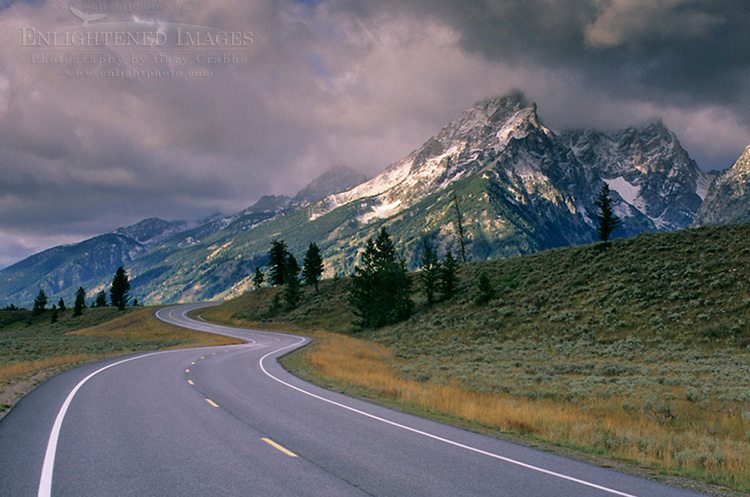
Picture: Curving road below mountain range dusted by first snow of fall, Grand Teton National Park, Wyoming
(Click here to purchase a print or license for use in publications. – ID# gtnp-1097e)
People often ask how I got started in photography. It surprises many to learn this wasn’t a chosen path of a deep-seated, had-to-follow passion. I stumbled into my profession by accident, and my diving board into the world of photography was being a breakfast cook.
I wound up taking a basic black and white photography course during the senior year of my bachelor’s degree in college because I was looking for an easy elective course credit.
 I got to use my newly-learned photography skills while getting my Master’s Degree in Theater when I landed a job as the department’s official photographer. I shot T-Max 3200 ASA B&W film hand-held with my Minolta x370 camera (no flash) while onstage with actors during final dress rehearsals of new theatrical productions. After the shoot, I’d go back to my apartment to develop the film and print twenty 8″ x 10″ Black & White RC prints. By the next evening, the prints would be mounted and hung in the lobby of the theater as decoration for the opening night performance.
I got to use my newly-learned photography skills while getting my Master’s Degree in Theater when I landed a job as the department’s official photographer. I shot T-Max 3200 ASA B&W film hand-held with my Minolta x370 camera (no flash) while onstage with actors during final dress rehearsals of new theatrical productions. After the shoot, I’d go back to my apartment to develop the film and print twenty 8″ x 10″ Black & White RC prints. By the next evening, the prints would be mounted and hung in the lobby of the theater as decoration for the opening night performance.
I worked as a cook since I was a junior in high school. After graduating with my master’s degree in 1990 and returning home to the San Francisco Bay Area, I again found myself stuck behind a grill starting every day at 5:00 AM. I soon became so unhappy that I started applying for any other job I could find, as long as it was regular Monday through Friday, 9-5 position. One ad I applied for read, “Outdoor Photo Agency; must love dogs.” I had no idea what an outdoor photo agency was, but I knew I loved the outdoors, and dogs, and I really liked photography. The job I landed was working in the stock photo department of famous adventure photographer, Galen Rowell. Just nine days after starting my new position, and having been exposed to some of the world’s greatest outdoor photography, I left for three weeks to get married and honeymoon in Hawaii. I purchased my first few rolls of color print film, and as the plane carried us off to Hawaii, my feeble photographic brain was building my expectations, telling me that I’d be coming home with all sorts of world-class, quality landscape photos. Yeah, well… that did SO NOT HAPPEN.
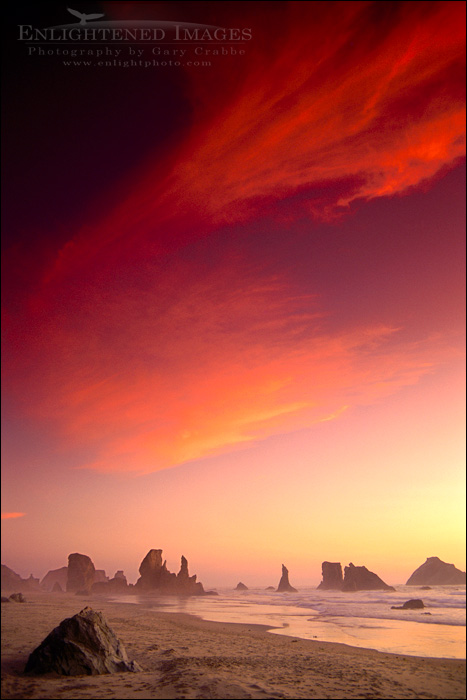 Photo: Bandon, Oregon.
Photo: Bandon, Oregon.
(Nikon n8008s w/ Fuji Velvia © 1991)
(Click here to purchase a print or license for use in publications. – ID# bandon001)
A year later I went on my first real “photography” vacation to the Oregon coast. During that previous year, I worked through several photo workshops taught by my boss. I also bought a new camera and transitioned to shooting slide film — which had practically no latitude for making any exposure mistakes. My basic understanding of photography had grown over that year such that I arrived home from the Oregon Coast with what I thought were a dozen great photos. Looking back, most of those great photos barely rise to something I’d consider good or decent. But I was definitely starting to understand how subject, light, and composition could come together to form a pleasing and communicative visual image.
For the next fifteen years, I exclusively shot slide film. The best lesson I learned back then was to look through the camera viewfinder and visualize the scene the way film would see it, and not as how my eyes were actually seeing the world. Understanding that film visually interpreted the world differently than our eyes was like learning to see in the same way you learn to speak a different language.
When I left my job in 1999, the photographic world was just taking its first steps into the digital arena. Kodak had a 6-Mp camera that cost $30,000.00. Around the same time, Nikon introduced its ‘affordable’ 2-Mp D1 camera for a paltry $5,000.00. Over the next few years, Canon roared ahead of Nikon in the DSLR marketplace, and many Nikon shooters divested their collection of lenses to make the switch. I didn’t make the switch until I felt the Image Quality (IQ) of digital was close or equal to 35mm transparency film. The choice to stay with my Nikon lenses meant waiting almost two extra years since Nikon lagged well behind Canon in the resolution quality of their early DSLR cameras. Finally, in 2005 Nikon released its first real flagship model, the 12.4-Mp D2x. Built like a battle tank, it only took a couple shoots to realize that my days of using film were done. While there were still some benefits to using film, I never really looked back.
Picture: Lone oak tree and rolling hills in spring and golden sunset light, Mount Diablo State Park, California (Nikon D2x ©2005)
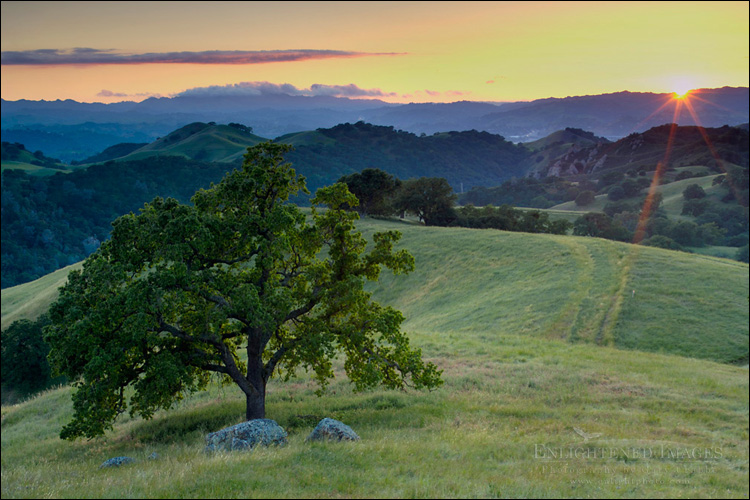
(Click here to purchase a print or license for use in publications. – ID# mtd-2045)
For many years into my own digital era, I thought anything below a good DSLR wasn’t a ‘real’ camera, especially if it couldn’t make a good 24″ x 36″ print. But as the great saying goes, “through the eyes of a child…”
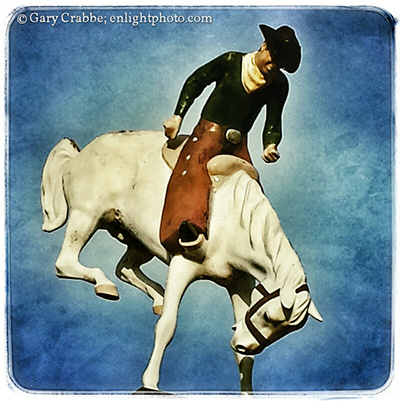 Photo: Livermore cowboy
Photo: Livermore cowboy
(Samsung Galaxy S4 ©2014)
In 2013, my then 12-year old daughter finally convinced me to start using my phone to take a few pictures. She really wanted me to have an Instagram account. I began using my phone to take an occasional photo. But since they weren’t ‘real’ photos, I started playing around with some photo filter and processing apps. I realized much to my own surprise that I was starting to enjoy the simple act of looking and creating photos without the need for any of my ‘professional’ picture-taking auspices.
Just over a year ago I purchased my very first point-n-shoot camera, the Sony RX100mIII. This little 20-Mp monster finally delivered a professional level IQ and still fit in my pocket while hiking. It was also one of the few pocket-sized point-n-shoot models that was on my stock agent’s approved camera list. Like the portability of my phone, this little camera further re-ignited a whole world of spontaneous, fun, and reactive photography that is often quashed when using much heavier and larger gear. It has also proved to be a great tool for teaching during my photo workshops. It allows me to demonstrate compositions quickly and easily, as well as allowing me to take photos of the participants and locations without having to spend time messing around with my larger DSLR gear.
I currently use a Nikon D800 as my primary ‘real’ camera for shooting larger landscape scenes. And while I never got into the crazy world of hyper-processed HDR images, one of the things I’ve loved about the new sensor technology is the high dynamic range that can be captured with a single frame. But there’s no arguing that gear is big and heavy. For all the quality it produces, it isn’t as conducive to shooting in a quick, easy, or light style — though it’s still much better in those regards than using a medium or large-format camera system.
Picture: Sunrise over boat launch building on Tomales Bay at Inverness, near Point Reyes, Marin County, California (Nikon D800 ©2015)
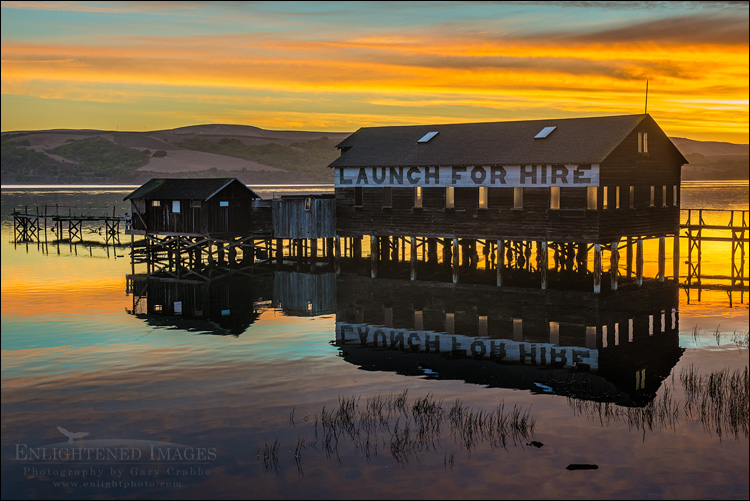
(Click here to purchase a print or license for use in publications. – ID# 151022a_BA2-0150)
It’s an interesting time to consider where things are going when looking into the photographic future. Imaging technology is changing and improving so fast, with better quality coming in smaller, easier to use devices. Along with the awesome RX series of point-n-shoot camera’s, both Sony and Fuji have been receiving very high praise for their mirrorless camera systems that weigh far less than a DSLR counterpart. The Apple iPhone 6 shoots high-speed video, and the photos produced have been featured on an international billboard campaign — a placement once reserved as a hallmark of the print industry’s need for high-quality images. I’ve also been intrigued hearing about the LIGHT camera and the new technology which will use 16 built-in lenses to render an impressive 50+Mp image from a device that will still fit in your pocket. Along with the Light, cameras like the RX100mIV and the GoPro Hero 4 now shoot 4K video. GoPro has excelled in bringing extremely small, portable devices to an active outdoor market which thrives on capturing experiences in a POV perspective. The other attractive, though problematic direction technology has been pushing our vision is up. The development of drone technology by companies like DJI (and now also GoPro) combined with small, high-resolution cameras give a wonderful new aerial perspective on the world previously only granted those with kite- or balloon-tethered cameras, or those with access to a plane. I’d love to be creating images with this new technology, yet I remain quite sensitive that it is seen by many people as an invasive technology.
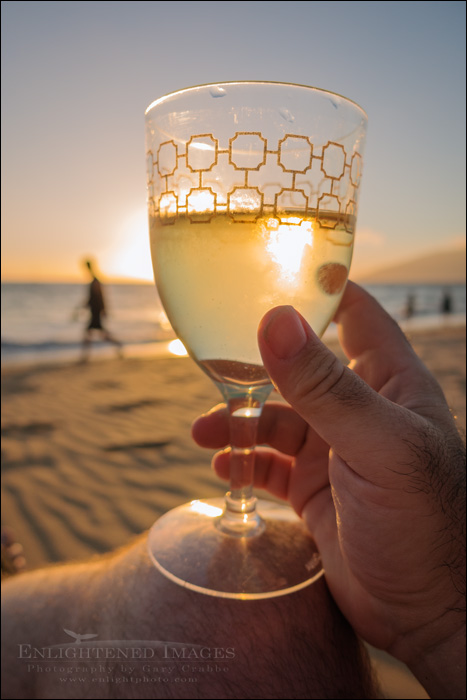 Picture: Relaxing on Kamole Beach, Kihei, Maui, Hawaii (Sony Rx100mIII © 2014) (Click here to purchase a print or license for use in publications. – ID# 140818rx_HI-0709)
Picture: Relaxing on Kamole Beach, Kihei, Maui, Hawaii (Sony Rx100mIII © 2014) (Click here to purchase a print or license for use in publications. – ID# 140818rx_HI-0709)
Where is my own photographic road going from here? Who knows? I know I’m not driven by a compulsive quest to capture only epic scenery in hopes of garnering thousands of Internet likes. I’ve found that can breed a mindset which isn’t very healthy. It also seems best left to those with the energy and desire to go from one trophy shot or location to another. Don’t get me wrong, I love getting my own trophy shots as much as the next photographer. But if I’ve learned anything over my 25-year career, it’s that chasing those me-too shots are never as personally satisfying as getting the shots which arise from developing and pursuing one’s own personal vision. For myself, if camera technology continues to make it easier and more fun to simply play at taking pictures again, and lets me come home with images that speak my own personal vision of the world, then I’m happy to leave it at that and see what comes next.
Stay tuned…
—
![]()
If you like this post , I would greatly appreciate it if you’d consider sharing this with your friends using one of the Social Media sharing buttons located at the top or bottom of this post. You can also sign up to receive free updates by email when future posts are made to this blog.
![]()
—
Gary Crabbe is an award-winning commercial and editorial outdoor travel photographer and author based out of the San Francisco Bay Area, California. He has seven published books on California to his credit, including “Photographing California; v1-North”, which won the prestigious 2013 IBPA Benjamin Franklin Gold Medal award as Best Regional title. His client and publication credits include the National Geographic Society, the New York Times, Forbes Magazine, TIME, The North Face, Subaru, L.L. Bean, Victoria’s Secret, Sunset Magazine, The Nature Conservancy, and many more. Gary is also a photography instructor and consultant, offering both public and private photo workshops. He also works occasionally a professional freelance Photo Editor.

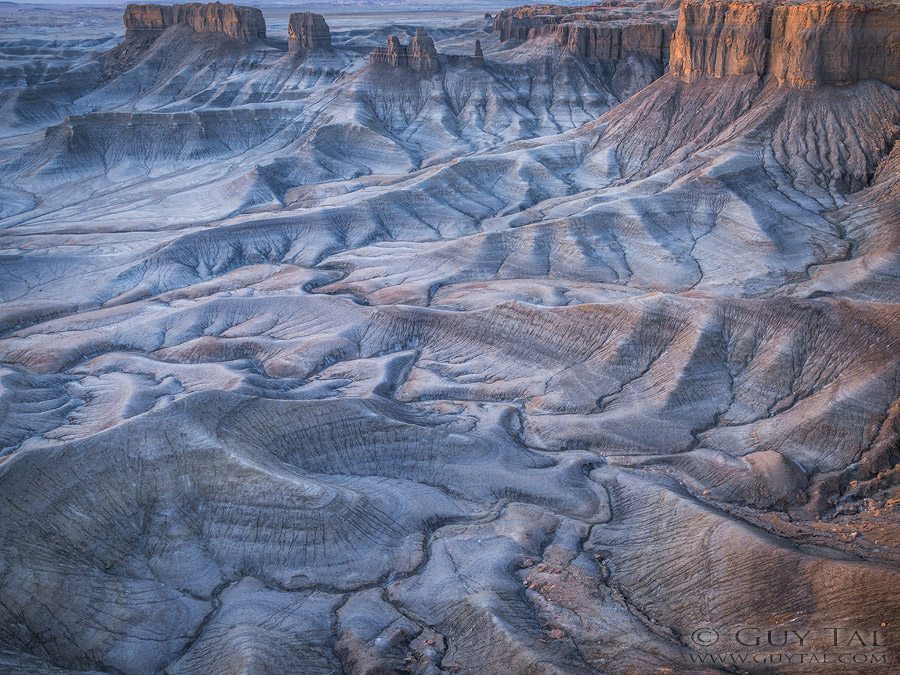



Enjoyed this post about your photographic journey. After photographic most of my life with film, I too am happily surprised by the dynamic range that can be captured with a single frame digital image.
Fascinating how the road you’re on can lead to the most unexpected places along your life’s journey. Yours is a most amazing story! Thanks for sharing it. You are a very good writer, as well. Wishing much joy and many blessings for you and your beautiful, precious family over the holidays and the year to come!
Great to read more about your story, Gary, and see some more excellent imagery. I particularly like that one of Bandon, Oregon. Did you know that “Launch for Hire” is Stefan’s boathouse? That’s probably the best photograph of it that I’ve seen. Stefan has a whole collection of them. As far as the story of your career goes, don’t forget my interview of you that I thought turned out very well: http://landscapephotographyblogger.com/interview-of-gary-crabbe-part-1/ Keep the great work up. Many of us are looking forward to chapters to come…